1997 PONTIAC BONNEVILLE ESP
[x] Cancel search: ESPPage 16 of 405
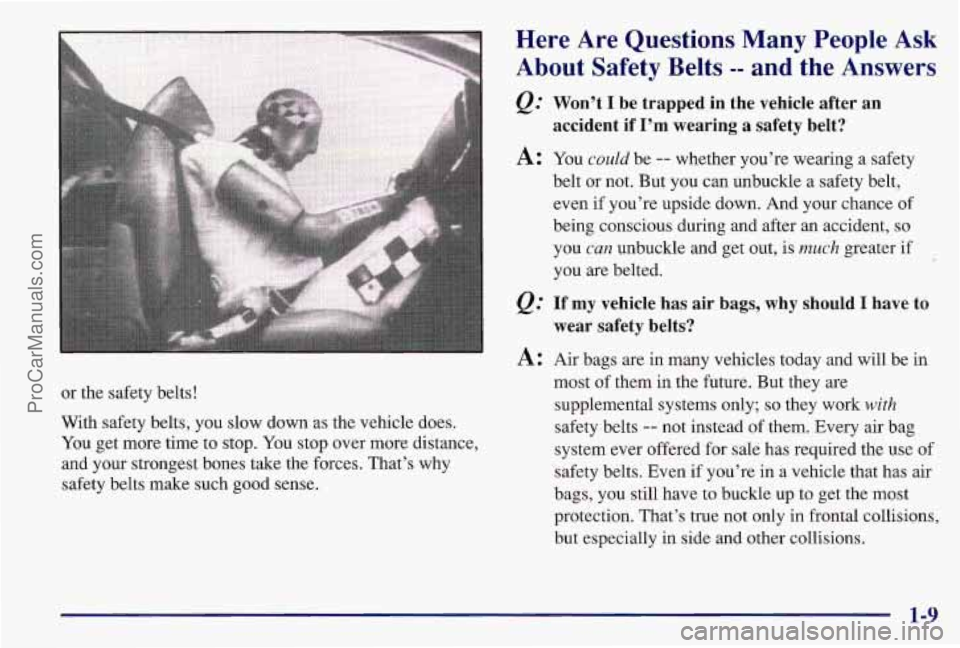
or the safety belts!
With safety belts, you slow down as the vehicle does.
You get more time to stop. You stop over more distance,
and your strongest bones take the forces. That’s why
safety belts
make such good sense.
Here Are Questions Many People Ask
About Safety Belts
-- and the Answers
Won’t I be trapped in the vehicle after an
accident if I’m wearing a safety belt?
A: You could be -- whether you’re wearing a safety
belt or not. But you can unbuckle a safety belt,
even if you’re upside down. And your chance
of
being conscious during and after an accident, so
you can unbuckle and get out, is much greater if
you are belted.
e.’ If my vehicle has air bags, why should I have to
wear safety belts?
A: Air bags are in many vehicles today and will be in
most
of them in the future. But they are
supplemental systems only;
so they work with
safety belts -- not instead of them. Every air bag
system ever offered for sale has required the use of
safety belts. Even
if you’re in a vehicle that has air
bags, you still have to buckle up to get the most
protection. That’s true not only
in frontal collisions,
but especially in side and other collisions.
1-9
ProCarManuals.com
Page 57 of 405
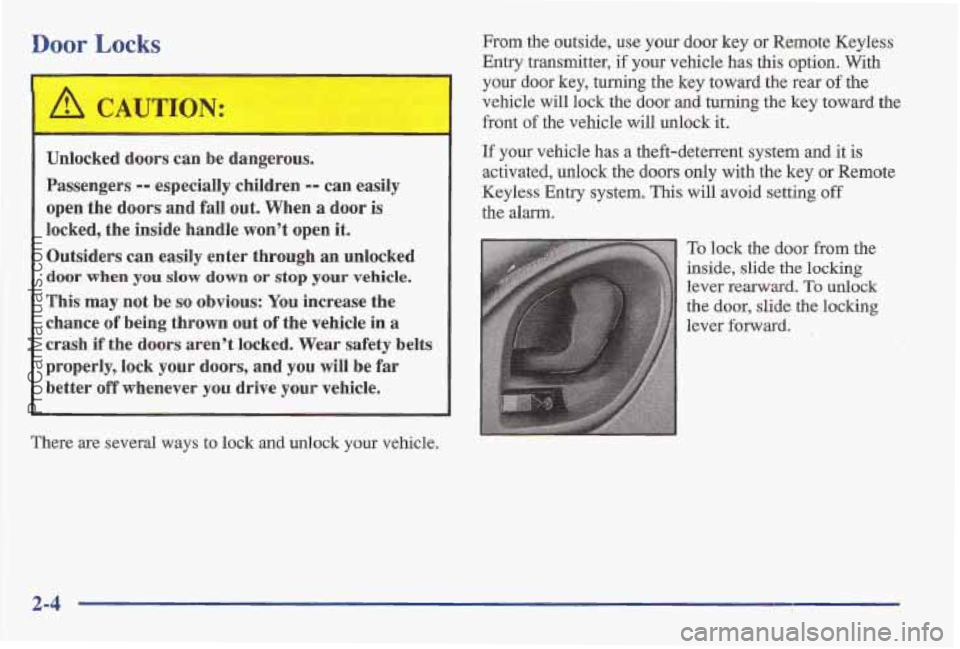
Door Locks
Unlocked doors can be dangerous.
Passengers
-- especially children -- can easily
open the doors and fall
out. When a door is
locked, the inside handle won’t open it.
Outsiders can easily enter through an unlocked
door when you slow down or stop your vehicle.
This may not be so obvious: You increase the
chance
of being thrown out of the vehicle in a
crash if the doors aren’t locked. Wear safety belts
properly, lock your doors, and
you will be far
better
off whenever you drive your vehicle.
There
are several ways to lock and unlock your vehicle.
From the outside, use your door key or Remote Keyless
Entry transmitter, if your vehicle has this option. With
your door key, turning the key toward the rear of the
vehicle will lock
the door and turning the key toward the
front
of the vehicle will unlock it.
If your vehicle has a theft-deterrent system and it is
activated, unlock
the doors only with the key or Remote
Keyless
Entry system. This will avoid setting off
the alarm.
To lock the door
from the
inside,
slide the locking
lever rearward.
To unlock
the door, slide the locking
lever forward.
,
2-4
ProCarManuals.com
Page 69 of 405
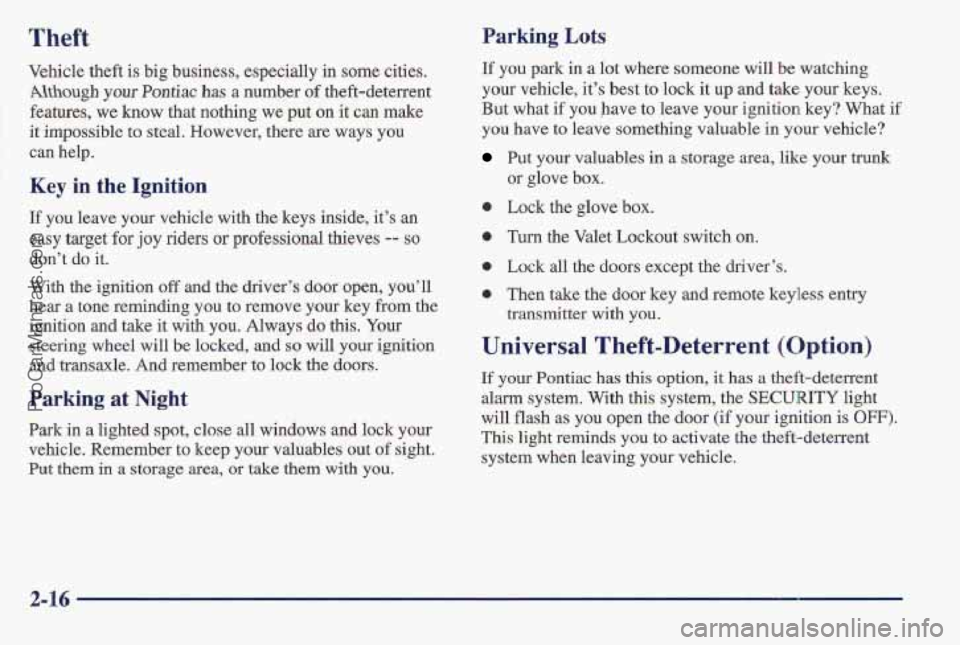
Theft Parking Lots
Vehicle theft is big b’usiness, especially in some cities.
Although
your Pontiac has a number of theft-deterrent
features, we know that nothing we put
on it can make
it impossible to steal. However, there are ways you
can help.
Key in the Ignition
If you leave your vehicle with the keys inside, it’s an
easy target for
joy riders or professional thieves -- so
don’t do it.
With the ignition
off and the driver’s door open, you’ll
hear
a tone reminding you to remove your key from the
igniti’on and take it with you. Always do this. Your
steering wheel will be locked, and
so will your ignition
and transaxle. And remember to lock the doors.
Parking at Night
Park in a lighted spot, close all windows and lock your
vehicle. Remember
to keep your valuables out of sight.
Put
them in a storage area, or take them with you. If you
park in
a lot where someone will be watching
your vehicle, it’s best to lock it up and take your keys.
But what
if you have to leave your ignition key? What if
you have to leave something valuable in your vehicle?
Put your valuables in a storage area, like your trunk
or glove box.
0 Lock the glove box.
0 Turn the Valet Lockout switch on.
0 Lock all the doors except the driver’s.
0 Then take the door key and remote keyless entry
transmitter with you.
Universal Theft-Deterrent (Option)
If your Pontiac has this option, it has a theft-deterrent
alarm system. With this system, the SECURITY light
will flash as you open the door (if your ignition
is OFF).
This light reminds you to activate the theft-deterrent
system when leaving your vehicle.
2-16
ProCarManuals.com
Page 97 of 405
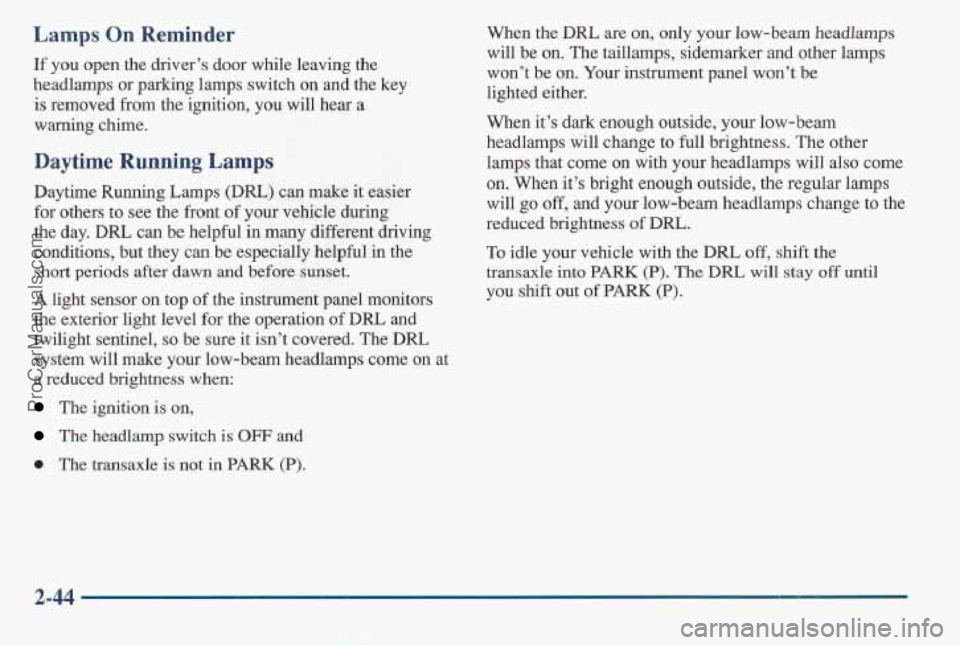
Lamps On Reminder
If you open the driver’s door while leaving the
headlamps or
parking lamps switch! on and the key
is removed from the ignition, you will hear a
warning chime.
Daytime Running Lamps
Daytime Running Lamps (Dm) can make it easier
for others to see the front of your vehicle during
the day. DRL can be helpful in many different driving
conditions, but they can be especially helpful in the
short periods after dawn and before sunset.
A light sensor on top of the instrument panel monitors
the exterior light level for the operation
of DRL and
twilight sentinel,
so be sure it isn’t covered. The DlU
system will make your low-beam headlamps come on at
a reduced brightness when:
The ignition is on,
The headlamp switch is OFF and
0 The transaxle is not in PARK (P).
When the DRL are on, only your low-beam headlamps
will be
on. The taillamps, sidemarker and other lamps
won’t be on. Your instrument panel won’t be
lighted either.
When it’s dark enough outside, your low-beam
headlamps will change
to full brightness. The other
lamps that
come on with your headlamps will also come
on. When it’s bright enough outside, the regular lamps
will go
off, and your low-beam headlamps change to the
reduced brightness
of DRL.
To idle your vehicle with the DRL off, shift the
transaxle into
PARK (P). The DRL will stay off until
you shift out of
PARK (P).
2-44
ProCarManuals.com
Page 169 of 405
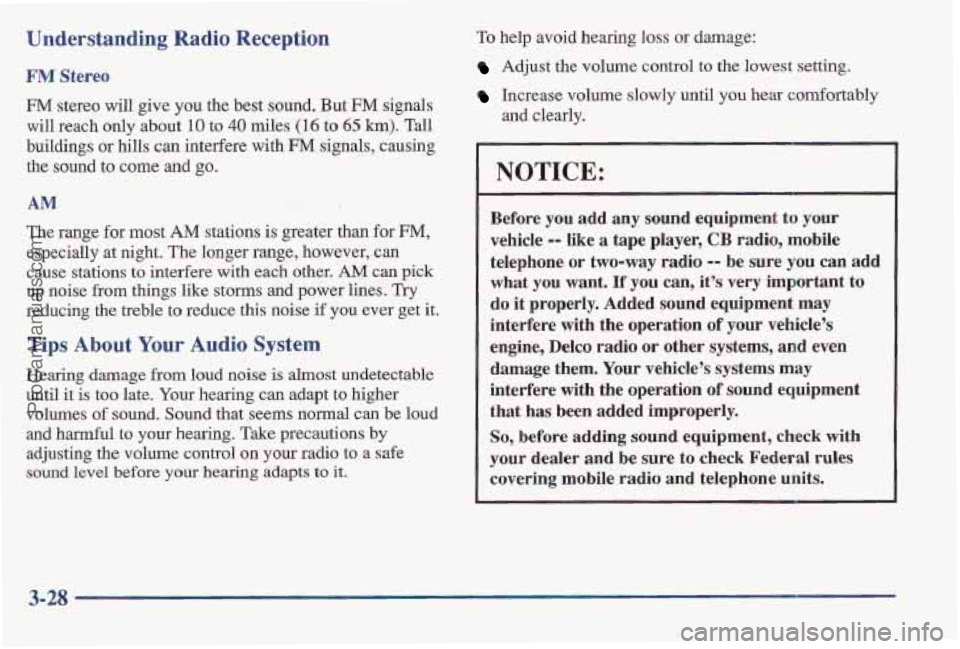
Understanding Radio Reception
FM Stereo
FM stereo will give you the best sound. But mcl signals
will reach only about
10 to 40 miles (16 to 65 km). Tall
buildings
or hills can interfere with FM signals, causing
the sound
to come and go.
AM
The range for most AM stations is greater than for FM,
especially at night. The longer range, however, can
cause stations to interfere
with each other. AM can pick
up noise from things like storms and power lines. Try
reducing the treble to reduce this noise if
you ever get it.
Tips About Your Audio System
Hearing damage from loud noise is almost undetectable
until it is too late. Your hearing can adapt to higher
volumes of sound. Sound that
seems normal cin be loud
and harmful to your hearing. Take precautions by
adjusting the volume control on your radio to a safe
sound level before your hearing adapts to it.
To help avoid hearing loss or damage:
Adjust the volume control to the lowest setting.
Increase volume slowly until you hear comfortably
and clearly.
I NOTICE:
Before you add any sound equipment to your
vehicle
-- like a tape player, CB radio, mobile
telephone or two-way radio
-- be sure you can add
what you want. If you can, it’s very important to
do it properly. Added sound equipment may
interfere with the operation
of your vehicle’s
engine, Delco radio or other systems, and even
damage them. Your vehicle’s systems may
interfere with the operation
of sound equipment
that has been added improperly.
So, before adding sound equipment, check with
your dealer and be sure to check Federal rules
covering mobile radio and telephone unit,s.
3-28 J--
ProCarManuals.com
Page 178 of 405
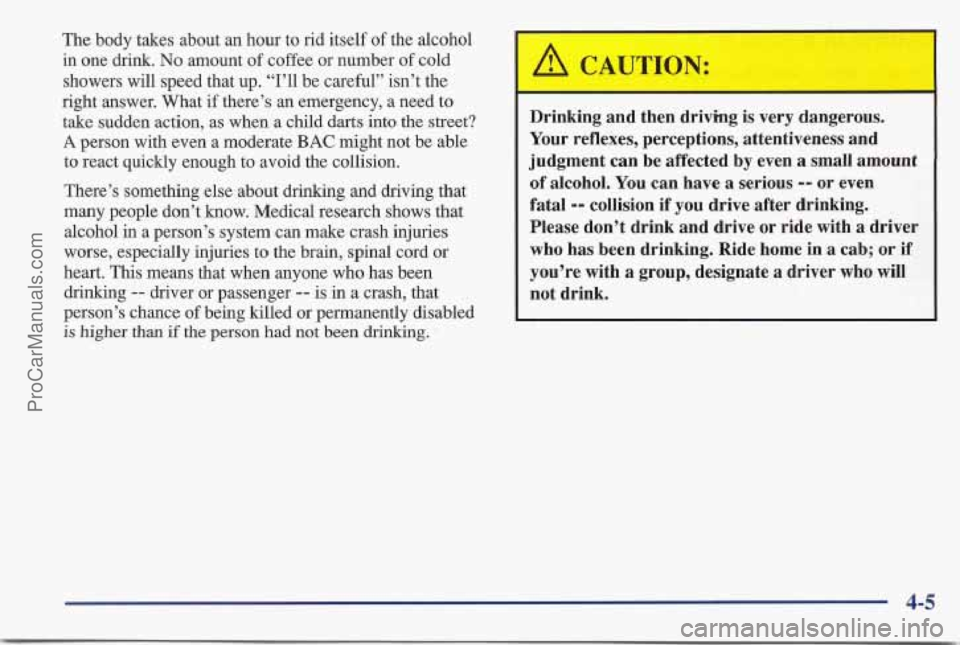
The body takes about an hour to rid itself of the alcohol
in one drink.
No amount of coffee or number of cold
showers will speed that up.
“I’ll be careful” isn’t the
right answer. What
if there’s an emergency, a need to
take sudden action, as when a child darts into the street?
A person with even a moderate BAC might not be able
to react quickly enough to avoid the collision.
There’s something else about drinking and driving that
many people don’t know. Medical research shows that
alcohol in a person’s system can make crash injuries
worse, especially injuries to the brain, spinal cord
or
heart. This means that when anyone who has been
drinlung
-- driver or passenger -- is in a crash, that
person’s chance
of being killed or permanently disabled
is higher than if the person had not been drinking. Drinking and then driving
is very dangerous.
Your reflexes, perceptions, attentiveness and
judgment can be affected
by even a small amount
of alcohol. You can have a serious -- or even
fatal
-- collision if you drive after drinking.
Please don’t drink and drive or ride with
a driver
who has been drinking. Ride home in
a cab; or if
you’re with a group, designate a driver who will
not drink.
4-5
ProCarManuals.com
Page 182 of 405
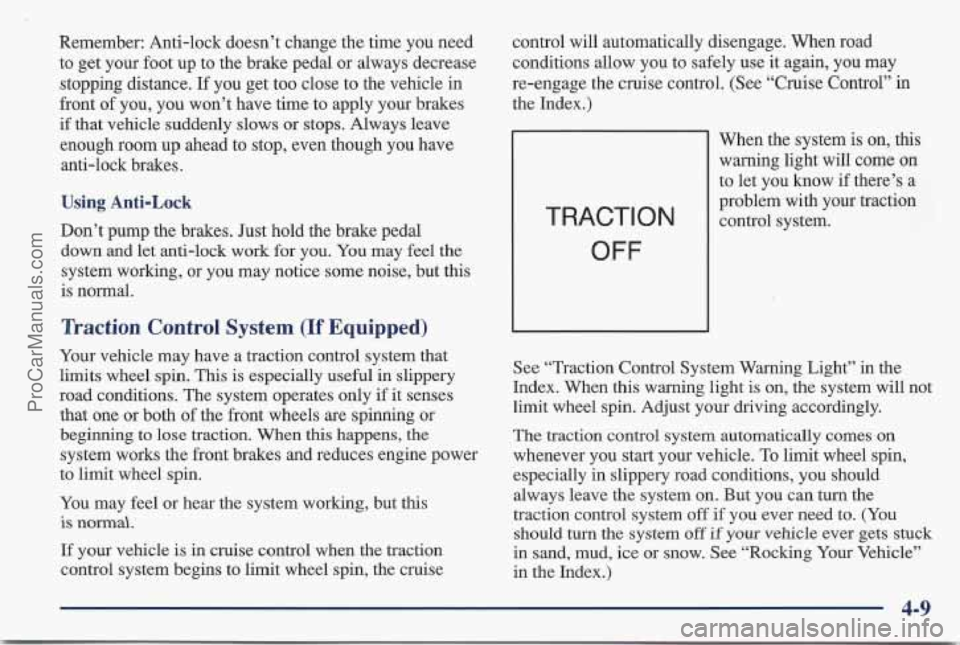
Remember: Anti-lock doesn’t change the time you need
to get your foot up to the brake pedal or always decrease
stopping distance.
If you get too close to the vehicle in
front of you, you won’t have time to apply your brakes
if that vehicle suddenly slows or stops. Always leave
enough room
up ahead to stop, even though you have
anti-lock brakes.
Using Anti-Lock
Don’t pump the brakes. Just hold the brake pedal
down and let anti-lock work for you. You may feel the
system working, or you may notice some noise, but this
is normal.
Traction Control System (If Equipped)
Your vehicle may have a traction control system that
limits wheel spin. This is especially useful in slippery
road conditions. The system operates only
if it senses
that one or both of the front wheels are spinning or
beginning to lose traction. When this happens, the
system works the front brakes and reduces engine power
to limit wheel spin.
You may feel or hear the system working, but this
is normal.
If your vehicle is in cruise control when the traction
control system begins to limit wheel spin, the cruise control
will automatically disengage. When road
conditions allow you to safely use it again, you may
re-engage the cruise control. (See “Cruise Control”
in
the Index.)
L
When the system is on, this
warning light will come on
to let you know if there’s a
problem with your traction
TRACT1 0 N control system.
OFF
-
See “Traction Control System Warning Light” in the
Index. When this warning light is on, the system will not
limit wheel spin. Adjust your driving accordingly.
The traction control system automatically comes
on
whenever you start your vehicle. To limit wheel spin,
especially in slippery road conditions,
you should
always leave the system on. But you can turn the
traction control system
off if you ever need to. (You
should turn
the system off if your vehicle ever gets stuck
in sand, mud, ice or snow. See “Rocking Your Vehicle’’
in the Index.)
4-9
ProCarManuals.com
Page 187 of 405
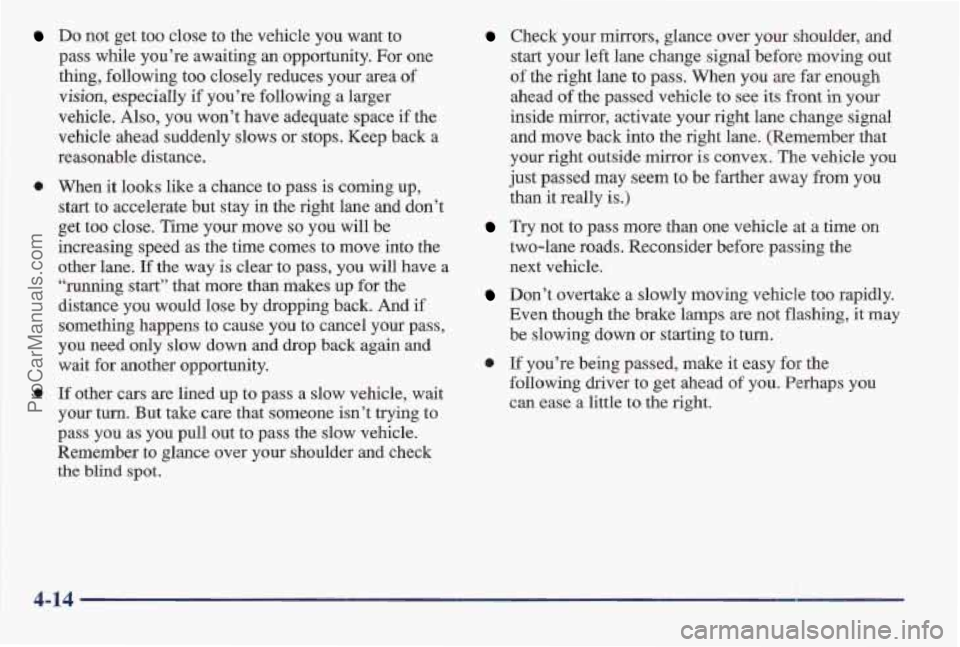
Do not get too close to the vehicle you want to
pass while you’re awaiting an opportunity. For one
thing, following too closely reduces your area of
visim, especially if you’re following a larger
vehicle.
Also, you won’t have adequate space if the
vehicle ahead suddenly slows
or stops. Keep back a
reasonable distance.
0 When it looks like a chance to pass is corning up,
start to accelerate but stay in the right lane and don’t
get too close. Time
your move so you will be
increasing speed as the time comes to move into the
other lane. If the way is
clear to pass, you will have a
“running stat’’ that more than makes up for the
distance you would lose by dropping back. And if
something happens to cause you to cancel your pass,
you need only slow down
and drop back again and
wait for another opportunity.
0 If other cars are lined up to pass a slow vehicle, wait
your turn. But take care that someone isn’t trying to
pass you as you pull out to pass the slow vehicle.
Remember
to glance over your shoulder and check
the blind spot.
Check your mirrors, glance over your shoulder, and
start your left lane change signal before moving out
of the right lane to pass. When you are far enough
ahead
of the passed vehicle to see its front in your
inside mirror, activate your right lane change signal
and move back into the right lane. (Remember that
your right outside mirror is convex. The vehicle you
just passed may seem
t’o b’e farther away from you
than it really
is.)
Try not to pass more than one vehicle at a time on
two-lane roads. Reconsider before passing the
next vehicle.
Don’t overtake a slowly moving vehicle too rapidly.
Even though the brake lamps are not flashing,
it may
be slowing down or starting to turn.
I, If you’re being passed, make it easy for the
following driver to get
head of you. Perhaps you
can ease a little to the right.
4-14
ProCarManuals.com